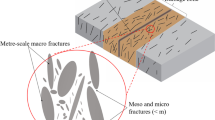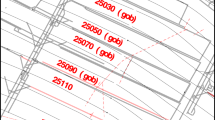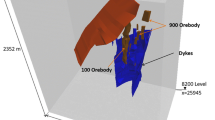Abstract
Deep underground mining/excavation in rock masses can induce unstable slip of a fault, triggering a common catastrophic geological hazard, fault-slip burst. Although several studies investigated the induced dynamic movement of a fault, the role of roughness heterogeneity in controlling fault instability remains poorly understood. Here, we simulated the stable/unstable slip of faults with heterogeneous roughness at both laboratory and field scales using the Universal Distinct Element Code (UDEC) incorporating the continuously yielding joint model. The heterogeneity of fault roughness was realized in UDEC by assigning stochastic-generated contact properties statistically following the classic Weibull function. We found that both the failure pattern and energy partition of the heterogeneous fault undergoing unstable slip were heavily constrained by the mechanical and geometric heterogeneity of the surface asperities. Aseismic faults can be seismic when heterogeneities in shear stiffness and initial friction angle were accounted for, and the higher degree of heterogeneity, the higher the released seismic energy and thus the induced moment magnitude. Therefore, rational assessment of the risk of fault-slip burst in rock-engineering practice should consider the modulation of the fault roughness heterogeneity on the stable-unstable transition of fault slip.

















Similar content being viewed by others
Data availability
The data supporting the findings of this study are available upon request to the corresponding author.
Abbreviations
- F :
-
Reduction factor in the continuously yielding (CY) joint model
- \({k}_{s}\) :
-
Joint shear stiffness
- m :
-
Homogeneity index of the randomly-distributed distribution properties
- m i :
-
Homogeneity index of the joint initial friction angle
- m k :
-
Homogeneity index of the contact shear stiffness
- M w :
-
Moment magnitude
- \({U}_{i}\) :
-
Initial strain energy
- \({U}_{k}\) :
-
Un-damped kinetic energy at every time-step in the system
- \({U}_{m}\) :
-
Energy transferred from mine-out material
- U r :
-
Residual strain energy
- W :
-
Work of the external force
- \({W}_{d}\) :
-
Damping energy
- \({W}_{k}\) :
-
Released seismic energy
- W p :
-
Plastic work
- \({\alpha }_{0}\) :
-
Mean value of the randomly-distributed properties (\(\alpha\))
- \(F\left(\alpha \right)\) :
-
Distribution function of the Weibull distribution
- \(\Phi (\alpha)\) :
-
Density function of the Weibull distribution
- \(\mu\) :
-
Distribution function of the Weibull distribution
- \({\tau}_m\) :
-
Target shear strength in the continuously yielding (CY) joint model
- \(\Delta \delta\) :
-
Instantaneous change of shear displacement
- \(\Delta \tau\) :
-
Instantaneous change of shear stress
- ΔW sw :
-
Instantaneous shear work which is the product of \(\Delta \delta\) and \(\Delta t\)
- jen :
-
Normal stiffness index of contact
- jes :
-
Shear stiffness index of contact
- jfric :
-
Internal friction angle of contact
- jif :
-
Initial friction angle of contact
- jkn :
-
Contact normal stiffness
- jks :
-
Contact shear stiffness
- jr :
-
Surface roughness parameter
References
Aubry J, Passelegue FX, Escartin J, Gasc J, Deldicque D, Schubnel A (2020) Fault stability across the seismogenic zone. Geophys Res Lett 125:2020JB019670
Bigarre P, Ben-Slimane K, Tinucci J (1993) Three-dimensional modeling of fault-slip rockbursting. The 3rd International Symposium on Rockbursts and Seismicity in Mines. Kingston, Belkema, pp 315–319
Brace WF, Byerlee JD (1966) Stick-slip as a mechanism for earthquakes. Science 153:990–992
Cook NGW (1965) A note on rockbursts considered as a problem of stability. J S Afr Inst Min Metall 65:437–446
Cundall PA, Hart RD (1984) Analysis of block test no.1 inelastic rock mass behavior: phase 2 - a characterization of joint behavior (final report). Minneapolis
Cundall PA, Lemos JV (1990) Numerical simulation of fault instabilities with a continuously-yielding joint model. The 2nd International Symposium on Rockbursts and Seismicity in Mines. Minneapolis, Balkema, pp 147–152
Dieterich HJ (1978) Time-dependent friction and the mechanics of stick-slip. Pure Appl Geophys 116:790–806
Duan K, Ji Y, Xu N, Wan Z, Wu W (2019) Excavation-induced fault instability: Possible causes and implications for seismicity. Tunn Undergr Space Technol 92:103041
Faradonbeh RS, Taheri A, Sousa LR, Karakus M (2020) Rockburst assessment in deep geotechnical conditions using true-triaxial tests and data-driven approaches. Int J Rock Mech Min Sci 128:104279
Fournier T, Morgan J (2012) Insights to slip behavior on rough faults using discrete element modeling. Geophys Res Lett 39:2012GL051899
Gao F, Kaiser PK, Stead D, Eberhardt E, Elmo D (2019) Strainburst phenomena and numerical simulation of self-initiated brittle rock failure. Int J Rock Mech Min Sci 116:52–63
Gao F, Kang H, Li J (2021) Numerical simulation of fault-slip rockbursts using the distinct element method. Tunn Undergr Space Technol 110:103805
Gong FQ, Si XF, Li XB, Wang SY (2018) Experimental investigation of strain rockburst in circular caverns under deep three-dimensional high-stress conditions. Rock Mech Rock Eng 52:1459–1474
Gu R, Ozbay U (2014) Distinct element analysis of unstable shear failure of rock discontinuities in underground mining conditions. Int J Rock Mech Min Sci 68:44–54
Hu L, Feng XT, Xiao YX, Wang R, Zhang W (2019a) Effects of structural planes on rockburst position with respect to tunnel cross-sections: a case study involving a railway tunnel in China. Bull Eng Geol Env 79:1061–1081
Hu L, Li Y, Liang X, Tang C, Yan L (2020) Rock damage and energy balance of strainbursts induced by low frequency seismic disturbance at high static stress. Rock Mech Rock Eng 53:4857–4872
Hu L, Liang X, Liang Z, Li Y, Tang C (2021) Influence of radial stress on strainbursts under true triaxial conditions: insights from a distinct element modelling. Int J Rock Mech Min Sci 138:104577
Hu L, Su G, Liang X, Li Y, Yan L (2019b) A distinct element based two-stage-structural model for investigation of the development process and failure mechanism of strainburst. Comput Geotech 118:103333
Itasca Consulting Group Inc (2016) UDEC (Universial Distinct Element Code), Version 6. Minneapolis
Jiang Q, Zhang M, Yan F, Su G, Feng G (2020) Effect of initial minimum principal stress and unloading rate on the spalling and rockburst of marble: a true triaxial experiment investigation. Bull Eng Geol Env 80:1061–1081
Kanamori H (1978) Quantification of Earthquakes. Nature 271:411–414
Keneti A, Sainsbury BA (2018) Review of published rockburst events and their contributing factors. Eng Geol 246:361–373
Khademian Z, Nakagawa M, Garvey R (2017) Role of fluid injection pressure in inducing seismicity. the 42nd Workshop on Geothermal Reservoir Engineering. Stanford, California, Stanford University, pp 212–217
Lebihain M, Roch T, Violay M, Molinari JF (2021) Earthquake nucleation along faults with heterogeneous weakening rate. Geophys Res Lett 48:e2021GL094901
Leeman JR, Saffer DM, Scuderi MM, Marone C (2016) Laboratory observations of slow earthquakes and the spectrum of tectonic fault slip modes. Nat Commun 7:11104
Li C, Mikula P, Simser B, Hebblewhite B, Joughin W, Feng X, Xu N (2019) Discussions on rockburst and dynamic ground support in deep mines. J Rock Mech Geotech Eng 11:206–214
Li Y, Du X, Ji Y (2022) Prediction of the transitional normal stress of rock joints under shear. Int J Rock Mech Min Sci 159:105203
Li Y, Su G, Pang J, Liu C, Yang X (2021) Mechanism of structural-slip rockbursts in civil tunnels: an experimental investigation. Rock Mech Rock Eng 54:2763–2790
Li Y, Sun S, Tang C (2020) Analytical prediction of the shear behavior of rock joints with quantified waviness and unevenness through wavelet analysis. Rock Mech Rock Eng 52:3645–3657
Lu C, Liu B, Liu B, Liu Y, Wang H, Zhang H (2019a) Anatomy of mining-induced fault slip and a triggered rockburst. Bull Eng Geol Env 78:5147–5160
Lu C, Liu G, Liu Y, Zhang H (2019b) Mechanisms of rockburst triggered by slip and fracture of coal-parting-coal structure discontinuities. Rock Mech Rock Eng 52:3279–3292
Ma T, Tang C, Tang S, Liang K, Yu Q, Kong D, Xu Z (2018) Rockburst mechanism and prediction based on microseismic monitoring. Int J Rock Mech Min Sci 110:177–188
Marone C (1998) Laboratory-derived friction laws and their application to seismic faulting. Annu Rev Earth Planet Sci 26:643–696
Marone C, Kilgore B (1993) Scaling of the critical slip distance for seismic faulting with shear strain in fault zones. Nature 362:618–621
Mei C, Barbot S, Wu W (2021) Period-multiplying cycles at the transition between stick-slip and stable sliding and implications for the Parkfield period-doubling tremors. Geophys Res Lett 48:2020GL091807
Meng F, Yuen W, Hui Z, Wang Z (2018) Comparative study on dynamic shear behavior and failure mechanism of two types of granite joint. Eng Geol 245:356–369
Meng F, Zhou H, Li S, Zhang C, Wang Z, Kong L, Zhang L (2016a) Shear behaviour and acoustic emission characteristics of different joints under various stress levels. Rock Mech Rock Eng 49:1–10
Meng F, Zhou H, Wang Z, Zhang L, Kong L (2016b) Experimental study on the prediction of rockburst hazards induced by dynamic structural plane shearing in deeply buried hard rock tunnels. Int J Rock Mech Min Sci 86:210–223
Michael RS, Thomas J (2018) Fault induced rock bursts and micro-tremors - experiences from the Gotthard Base Tunnel. Tunn Undergr Space Technol 81:358–366
Okubo PG, Dieterich JH (1985) Effects of physical fault properties on frictional instabilities produced on simulated faults. J Geophys Res 89:5817–5827
Sainoki A (2014) Dynamic modelling of fault-slip with Barton’s shear strength model. Int J Rock Mech Min Sci 67C:155–163
Sainoki A, Mitri HS (2014) Dynamic behaviour of mining-induced fault slip. Int J Rock Mech Min Sci 66:19–29
Salamon MDG (1970) Stability, instability and design of pillar workings. Int J Rock Mech Min Sci 7:613–631
Sun W, Li Y, Wu X, Tang C (2022) Roles of normal stress, roughness and slip displacement in the stability of laboratory fault in a sandstone. Appl Sci 12:11434
Tang C (1997) Numerical simulation of progressive rock failure and associated seismicity. Int J Rock Mech Min Sci 34:249–261
Wang J, Chen G, Xiao Y, Li S, Qiao Z (2021) Effect of structural planes on rockburst distribution: case study of a deep tunnel in Southwest China. Eng Geol 292:106250
Wei C, Zhang C, Canbulat I (2020) Numerical analysis of fault-slip behaviour in longwall mining using linear slip weakening law. Tunn Undergr Space Technol 104:103541
Wu W, Zhao Z, Duan K (2017) Unloading-induced instability of a simulated granular fault and implications for excavation-induced seismicity. Tunn Undergr Space Technol 63:154–161
Zhao Y, Bi J, Zhou XP (2020) Quantitative analysis of rockburst in the surrounding rock masses around deep tunnels. Eng Geol 273:105669
Zhou H, Chen S, Li H, Liu T, Wang H (2021) Rockburst prediction for hard rock and deep-lying long tunnels based on the entropy weight ideal point method and geostress field inversion: a case study of the Sangzhuling Tunnel. Bull Eng Geol Env 80:3885–3902
Zhou H, Meng F, Zhang C, Hu D, Yang F (2015) Analysis of rockburst mechanisms induced by structural planes in deep tunnels. Bull Eng Geol Env 74:1435–1451
Zielke O, Galis M, Mai PM (2017) Fault roughness and strength heterogeneity control earthquake size and stress drop. Geophys Res Lett 44:777–783
Zoheir K, Ozbay U (2018) Computational framework for simulating rock burst in shear and compression. Int J Rock Mech Min Sci 110:279–290
Zou D, Miller HDS, Kaiser PK (1989) Numerical study of violent rock failure by stick-slip on joints. Min Sci Technol 9:241–251
Funding
We thank the financial support from the National Natural Science Foundation of China (NSFC) (Grant No. 52179097 and 52009016).
Author information
Authors and Affiliations
Corresponding author
Ethics declarations
Conflict of interest
The authors declare no competing interests.
Supplementary Information
Below is the link to the electronic supplementary material.
Rights and permissions
Springer Nature or its licensor (e.g. a society or other partner) holds exclusive rights to this article under a publishing agreement with the author(s) or other rightsholder(s); author self-archiving of the accepted manuscript version of this article is solely governed by the terms of such publishing agreement and applicable law.
About this article
Cite this article
Li, Y., Zhang, F., Hu, L. et al. Distinct element modelling of mining-induced instability of a heterogeneous fault. Bull Eng Geol Environ 82, 69 (2023). https://doi.org/10.1007/s10064-023-03085-8
Received:
Accepted:
Published:
DOI: https://doi.org/10.1007/s10064-023-03085-8




